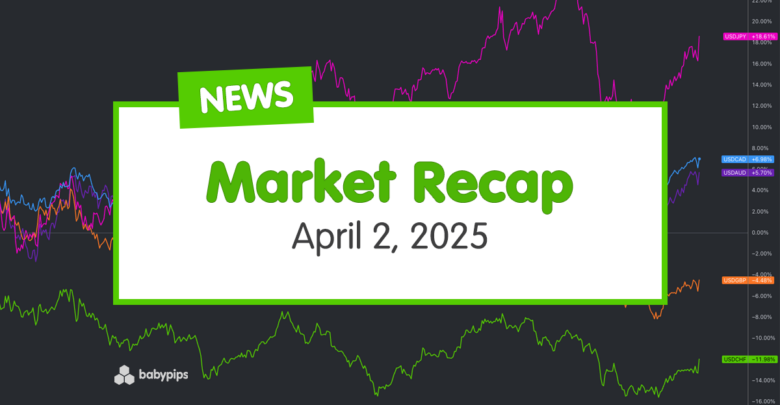Trump’s tariff bombshell and a red-hot ADP jobs report sent shockwaves through the markets, flipping risk sentiment and jolting major assets.
From gold’s record surge to the dollar’s wild ride, here’s what moved and why it matters.
Headlines:
- Australia building approvals for February: -0.3% m/m (-1.4% forecast, 6.9% previous)
- Bloomberg reported that China has taken steps to restrict local companies from investing in the U.S. amid trade tensions
- Speculations that Trump’s “Liberation Day” tariffs are ceilings that could be negotiated downward helped support risk sentiment early Wednesday
- RBA to raise prices of new OMO repos by 5 – 10bps above cash rate target, signaling a small shift toward tighter funding conditions
- U.S. ADP report for March: 155.0k (60.0k forecast; 77.0k previous)
- U.S. Factory orders for February: 0.6% m/m (0.3% forecast; 1.7% previous)
- U.S. EIA Crude Oil Stocks Change for March 28: 6.17M (-3.34M previous)
- ECB member Robert Holzmann said he didn’t see a reason to cut interest rates further
- U.S. President Trump unveiled a 10% minimum tariff on most imports, with much higher duties on products from dozens of countries
Broad Market Price Action:

Dollar Index, Gold, S&P 500, Oil, U.S. 10-yr Yield, Bitcoin Overlay Chart by TradingView
The major assets didn’t commit to directional moves early Wednesday as traders braced for the anticipated U.S. “Liberation Day” tariffs. Stocks managed to shake off early jitters and closed higher, but futures tanked after Trump’s speech. Tech took the biggest hit given its deep ties to Asian manufacturing. Over in Europe, markets slipped as investors stayed cautious.
Here are key points from Trump’s tariff announcement:
- Baseline 10% tariff on all imports to the U.S.
- China hit hardest with 34% tariff (total effective rate: 54%)
- Elimination of de minimis exemption for low-value shipments from China
- Manufacturing hubs in Taiwan facing tariffs above 30%
- No mention of significant tariffs on Canadian and Mexican goods
- Mexican President stated they would not impose retaliatory tariffs
- Tariffs described as a “cap” that countries could reduce through negotiations
In response, gold surged to a record high of $3,140 as investors sought safety. WTI crude oil prices jumped to $72.20 despite a surprise 6.2 million barrel build in U.S. inventories, but later pulled back to around $70.65 as demand worries crept in.
10-year Treasury yields fell sharply following strong ADP employment data (155K vs 105K expected) and factory orders, but reversed to 4.13% on tariff fears. Bitcoin demonstrated relative stability, trading in the $83,000-$85,000 range, while Asia-focused ETFs saw significant outflows.
FX Market Behavior: U.S. Dollar vs. Majors:

Overlay of USD vs. Major Currencies Chart by TradingView
The dollar had a mixed start to the day, slipping against the Aussie and Kiwi after Tuesday’s upbeat Chinese manufacturing data gave risk appetite a lift. That trend held through the European session, with the greenback broadly steady but still losing ground to the yen and antipodean currencies as traders stayed cautious ahead of Trump’s big tariff reveal.
In the U.S., stronger-than-expected data gave the dollar a temporary lift. ADP employment came in at 155K vs 105K expected, pushing yields higher and boosting the dollar. Factory orders also surprised to the upside, but USD/JPY stayed stuck below 149 as demand for safe havens held firm.
Things got volatile heading into Trump’s speech, and USD moves turned erratic in the final hour of trading. Once the tariffs were announced – and turned out to be tougher than expected, especially the 34% hit on China – the dollar spiked, then quickly reversed lower against traditional safe havens.
Meanwhile, the dollar simultaneously strengthened against emerging market currencies exposed to trade disruption, highlighting the complex market reaction to what one analyst called “the highest US tariff levels in over a century.”
Upcoming Potential Catalysts on the Economic Calendar:
- Switzerland CPI at 6:30 am GMT
- French final services PMI at 7:50 am GMT
- German final services PMI at 7:55 am GMT
- Euro Area final services PMI at 8:00 am GMT
- SNB member Tschudin to give a speech at 8:30 am GMT
- U.K. final services PMI at 8:30 am GMT
- Euro Area PPI at 9:00 am GMT
- ECB meeting minutes at 11:30 am GMT
- U.S. Challenger job cuts at 11:30 am GMT
- Canada trade balance at 12:30 pm GMT
- U.S. initial jobless claims at 12:30 pm GMT
- U.S. trade balance at 12:30 pm GMT
- U.S. final services PMI at 1:45 pm GMT
- U.S. ISM services PMI at 2:00 pm GMT
- FOMC Member Jefferson to give a speech at 4:30 pm GMT
- FOMC Member Cook to give a speech at 6:00 pm GMT
- Japan household spending at 11:30 pm GMT
The European session kicks off with Swiss CPI and a wave of final PMIs from France, Germany, and the Eurozone, while ECB minutes and a speech from SNB’s Tschudin could stir action in EUR and CHF pairs.
Over in the US, jobless claims, trade data, and the ISM services PMI headline a packed schedule, with Fed speakers Jefferson and Cook lined up to potentially shake rate expectations. Meanwhile, markets are treading carefully after Trump floated new tariffs, raising fresh concerns about trade tensions and inflation risks.
Don’t forget to check out our brand new Forex Correlation Calculator when taking any trades!
